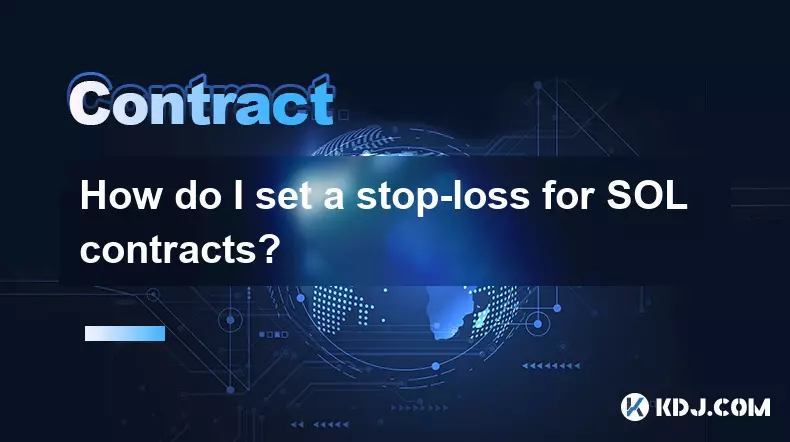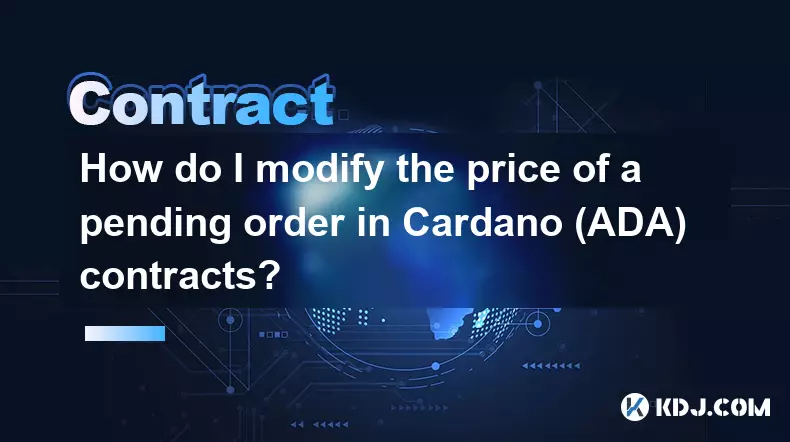-
 bitcoin
bitcoin $109523.663807 USD
-0.13% -
 ethereum
ethereum $4019.526508 USD
2.06% -
 tether
tether $1.000482 USD
0.00% -
 xrp
xrp $2.776815 USD
0.18% -
 bnb
bnb $958.942396 USD
0.12% -
 solana
solana $204.294698 USD
3.84% -
 usd-coin
usd-coin $0.999693 USD
0.00% -
 dogecoin
dogecoin $0.232115 USD
2.09% -
 tron
tron $0.338028 USD
0.84% -
 cardano
cardano $0.790920 USD
1.50% -
 hyperliquid
hyperliquid $44.871443 USD
5.60% -
 ethena-usde
ethena-usde $1.000322 USD
0.04% -
 chainlink
chainlink $21.034165 USD
2.60% -
 avalanche
avalanche $28.794831 USD
-0.54% -
 stellar
stellar $0.360466 USD
1.24%
How do I set a stop-loss for SOL contracts?
A stop-loss in SOL futures helps limit losses by automatically closing positions at a set price, crucial for managing risk amid crypto’s volatility.
Sep 25, 2025 at 01:18 pm

Understanding Stop-Loss in SOL Futures Trading
1. A stop-loss order is a risk management tool used to limit losses on a trade by automatically closing a position when the price reaches a predetermined level. In the context of SOL futures contracts, this becomes crucial due to the high volatility associated with cryptocurrency markets. Without a stop-loss, traders expose themselves to potentially significant drawdowns if the market moves sharply against their position.
2. When trading SOL futures on platforms like Binance, Bybit, or OKX, users can set stop-loss orders either as part of a conditional order at entry or modify existing positions to include one. These orders are typically placed below the entry price for long positions and above the entry price for short positions. The exact placement depends on individual risk tolerance and technical analysis levels such as support and resistance zones.
3. Traders must differentiate between a simple stop-loss and a stop-market versus stop-limit order. A stop-market triggers a market order once the stop price is hit, ensuring execution but not the price. A stop-limit allows setting both a stop price and a limit price, offering more control over execution price but risking non-execution during fast-moving markets.
4. Volatility spikes around major news events, protocol upgrades, or broader crypto market shifts can trigger premature stop-losses if not properly calibrated. Using average true range (ATR) indicators or recent price swings can help determine a more realistic stop distance that accounts for normal market noise.
Steps to Set a Stop-Loss on Major Exchanges
1. On Binance Futures, navigate to the SOL/USDT perpetual contract interface. After selecting “Limit” or “Market” order type, toggle on “Post-Only” or proceed directly to advanced options where “Take Profit / Stop-Loss” fields appear. Input your desired stop-loss price under the “Stop-Loss” section, choosing between 'Market' or 'Limit' execution mode.
2. Bybit offers a similar setup. While placing an order, expand the “Advanced” settings and enable “TP/SL.” Enter the stop-loss price or use percentage-based input. Users can also set trailing stop-loss from the active orders tab, which adjusts dynamically with favorable price movement.
3. On OKX, after entering the contract trading page for SOL, select either spot or futures mode. For futures, open the order panel and choose “Conditional Order.” Here, define the trigger price for the stop-loss and the execution type. You may link it to a filled entry order or set it independently.
4. Always confirm whether the stop-loss is tied to mark price or last traded price. Most reputable platforms default to mark price to prevent manipulation through temporary price spikes. This ensures the stop-loss triggers based on fair market value rather than isolated trades.
Risks and Best Practices for Stop-Loss Placement
1. Placing a stop-loss too close to the entry price may result in being stopped out by routine volatility, especially during low-liquidity periods. Analyzing historical candlestick patterns and identifying key psychological levels helps avoid arbitrary placements.
2. Using fixed dollar amounts or percentages without considering current market structure increases the likelihood of poor risk-reward ratios. Instead, align stop-loss with technical invalidation points—such as breaking below a rising trendline or surpassing a recent swing high in shorts.
3. Position size should be adjusted according to the distance of the stop-loss. A wider stop requires reducing position size to maintain consistent risk per trade, usually recommended between 1% to 2% of total capital.
4. Some traders combine stop-loss orders with hedging strategies using options or inverse positions, particularly during uncertain macroeconomic announcements. While more complex, these methods provide alternative downside protection beyond simple stop mechanisms.
Frequently Asked Questions
What is the difference between a stop-loss and a liquidation price?A stop-loss is a user-defined order to exit a position at a specified price to manage risk. The liquidation price is determined by the exchange based on margin levels and leverage; if reached, the position is forcibly closed to prevent negative equity.
Can I modify or cancel my stop-loss after setting it?Yes, most exchanges allow users to edit or remove stop-loss orders while the position remains open and the trigger price hasn't been hit. This applies to both attached conditional orders and standalone stop instructions.
Why didn’t my stop-loss execute even though the price reached my level?This may occur if the stop-loss was set as a stop-limit order and the limit price wasn’t met after triggering. Rapid price gaps can skip over limit prices. Additionally, some platforms require sufficient balance or may delay execution during extreme volatility.
Should I always use a stop-loss when trading SOL contracts?While not mandatory, consistently using stop-loss orders significantly improves long-term survival in leveraged trading. Even experienced traders face unpredictable market turns, making predefined exits essential for disciplined risk control.
Disclaimer:info@kdj.com
The information provided is not trading advice. kdj.com does not assume any responsibility for any investments made based on the information provided in this article. Cryptocurrencies are highly volatile and it is highly recommended that you invest with caution after thorough research!
If you believe that the content used on this website infringes your copyright, please contact us immediately (info@kdj.com) and we will delete it promptly.
- BlockchainFX: The Crypto Presale Primed for a 2025 ROI Explosion
- 2025-09-27 18:25:19
- ETH Price Check: Smart Money Stays Cool Amidst ATH Rollercoaster
- 2025-09-27 18:25:19
- Aster Price, MrBeast, and DEX Volumes: What's the Buzz?
- 2025-09-27 18:45:11
- Shiba Inu, Meme Coins, and MAGACOIN FINANCE: What's Next?
- 2025-09-27 18:45:11
- Aster DEX: Navigating DeFi's Future with Price Predictions and Key Insights
- 2025-09-27 18:50:01
- Virtuals Protocol's New Genesis: A Deep Dive into the Launch and $VIRTUAL's Potential
- 2025-09-27 18:50:01
Related knowledge

How do I enable the "scalping-only" mode for Cardano (ADA) contracts?
Sep 24,2025 at 03:19am
Understanding Scalping Strategies in Crypto Derivatives1. Scalping in cryptocurrency trading refers to executing multiple short-term trades within min...

How do I add margin to Cardano (ADA) contracts?
Sep 27,2025 at 07:54pm
Understanding Margin in Cardano (ADA) Smart ContractsCardano operates on a proof-of-stake blockchain that supports smart contracts through its Plutus ...

What is the maximum position limit for Cardano (ADA) contracts?
Sep 23,2025 at 11:00pm
Understanding ADA Futures and Derivatives Market Structure1. Cardano (ADA) futures contracts are offered by several major cryptocurrency derivatives e...

What is the maker fee for Cardano (ADA) contracts?
Sep 26,2025 at 09:01am
Understanding Maker Fees in Cardano (ADA) Contracts1. The concept of maker fees applies broadly across decentralized exchanges and smart contract plat...

How can I view open interest in Cardano (ADA) contracts?
Sep 24,2025 at 07:36am
Understanding Open Interest in Cardano Derivatives1. Open interest refers to the total number of outstanding derivative contracts, such as futures or ...

How do I modify the price of a pending order in Cardano (ADA) contracts?
Sep 27,2025 at 01:00am
Understanding Pending Orders in Cardano Smart Contracts1. Cardano operates on a proof-of-stake blockchain that supports smart contracts through its Pl...

How do I enable the "scalping-only" mode for Cardano (ADA) contracts?
Sep 24,2025 at 03:19am
Understanding Scalping Strategies in Crypto Derivatives1. Scalping in cryptocurrency trading refers to executing multiple short-term trades within min...

How do I add margin to Cardano (ADA) contracts?
Sep 27,2025 at 07:54pm
Understanding Margin in Cardano (ADA) Smart ContractsCardano operates on a proof-of-stake blockchain that supports smart contracts through its Plutus ...

What is the maximum position limit for Cardano (ADA) contracts?
Sep 23,2025 at 11:00pm
Understanding ADA Futures and Derivatives Market Structure1. Cardano (ADA) futures contracts are offered by several major cryptocurrency derivatives e...

What is the maker fee for Cardano (ADA) contracts?
Sep 26,2025 at 09:01am
Understanding Maker Fees in Cardano (ADA) Contracts1. The concept of maker fees applies broadly across decentralized exchanges and smart contract plat...

How can I view open interest in Cardano (ADA) contracts?
Sep 24,2025 at 07:36am
Understanding Open Interest in Cardano Derivatives1. Open interest refers to the total number of outstanding derivative contracts, such as futures or ...

How do I modify the price of a pending order in Cardano (ADA) contracts?
Sep 27,2025 at 01:00am
Understanding Pending Orders in Cardano Smart Contracts1. Cardano operates on a proof-of-stake blockchain that supports smart contracts through its Pl...
See all articles









































































